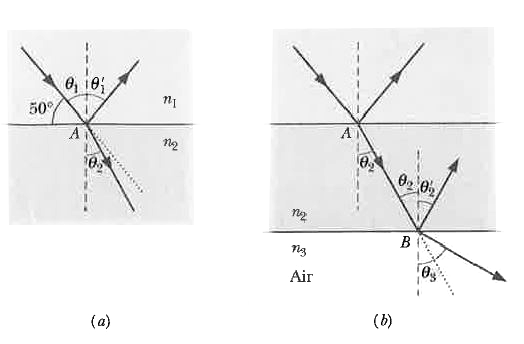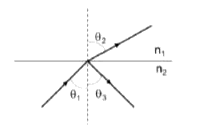(a) In Fig. 32-19a, a beam of monochromatic light reflects and refracts at point A on the interface between material 1 with index of refraction n1 = 1.33 and material 2 with index of refraction n2=1.77. The incident beam makes an angle of 50∘) with the interface. What is the angle of reflection at poinl A ? What is the angle of refraction there?
(1) The angle of reflection is equal to the angle of incidence, and both angles are measured relative to the normal to the surface at the point of reflection. (2) When light reaches the interface between two materials with different indexes of refraction ( call them n1 and n2 ), part of the light can be refracted by the interface according to Snell.s law, Eq. 33-35:
n2sinθ2=n1sinθ1
where both angles are measured relative to the normal at the point of refraction.
Calculations: In Fig. 32-19a, the normal at point A is drawn as a dashed line through the point. Note that the angle

of incidence θ , is not the given 50∘ but is 90∘−50∘=40∘. Thus, the angle of reflection is
θ1=θ1=40∘ .
The light that passes from material 1 into material 2 undergoes refraction at point A on the interface between the two materials. Again we measure angles between light rays and a normal, here at the point of refraction. Thus, in Fig. 32-19a, the angle of refraction is the angle marked θ2 Solving Eq. 32-37 for θ2 , gives us
θ2=sin−1(n1n2sinθ1)=sin−1(1.331.77sin40∘)
=28.88∘≈29∘ .
This result means that the beam swings toward the normal (it was at 40∘ to the normal and is now at 29∘.)
The reason is that when the light travels across the inter face, it moves into a material with a greater index of refraction. Caution: Note that the beam does not swing through the normal so that it appears on the left side of Fig. 32-194. (b) The light that enters material 2 at point A then reaches point B on the interface between material 2 and material 3, which is air, as shown in Fig. 32-19b. The interface through B is parallel to that through A. At B, some of the light reflects and the rest enters the air. What is the angle of reflection? What is the angle of refraction into the air?
Calculations: We first need to relate one of the angles at point B with a known angle at point A. Because the ntertace through point B IS parallel to that through point A, the incident angle at B must be equal to the angle of refraction θ2 as shown in Fig. 32-19b. Then for reflection we again use the law of reflection. Thus, the angle of reflection at B is
θ2=θ2=28.88∘≈29∘ .
Next, the light that passes from material 2 into the air undergoes refraction at pointB, with refraction angle θ3 Thus, we again apply Snell.s law of refraction, but this time we write Eq. 32-35 as
n3sinθ3=n2sinθ2.
Solving for θ3 then leads to
θ3=sin−1(n2n3sinθ2)=sin−1(1.771.00sin28.88∘)
=58.75∘≈59∘.
Thus, the beam swings away from the normal (it was at 29∘ to the normal and is now at 59∘) because it moves into a material (air) with a lower index of refraction
Topper's Solved these Questions
- ELECTROMAGNETIC WAVES BOOK - RESNICK AND HALLIDAYCHAPTER - ELECTROMAGNETIC WAVES EXERCISE - CHECKPOINT
3 Videos
- ELECTROMAGNETIC WAVES BOOK - RESNICK AND HALLIDAYCHAPTER - ELECTROMAGNETIC WAVES EXERCISE - PROBLEMS
29 Videos
- ELECTROMAGNETIC OSCILLATIONS AND ALTERNATING CURRENT BOOK - RESNICK AND HALLIDAYCHAPTER - ELECTROMAGNETIC OSCILLATIONS AND ALTERNATING CURRENT EXERCISE - Practice Questions (Integer)
7 Videos
- FLUIDSBOOK - RESNICK AND HALLIDAYCHAPTER - FLUIDSEXERCISE - PRACTICE QUESTIONS (Integer Type )
5 Videos
Similar Questions
A beam of light is partially reflected and partially refracted from a surface. The angle between reflected and refracted light ray is 90∘. If the angle of refraction is 30∘, the angle of incidence is
View SolutionA monochromatic beam of light is incident at the interface of two materials of refractive index n1 and n2 as shown . If n1>n2 and θC is the critical angle then which of the following statements is NOT true ?

View Solution
Knowledge Check
A beam of light propagating in medium A with index of refraction n ( A ) passes across an interface into medium B with index of refraction n ( B ). The angle of incidence is greater than the angle of refraction, v ( A ) and v ( B ) denotes the speed of light in A and B . Then which of the following is true
Av(A)>v(B) and n(A)>n(B)Bv(A)>v(B) and n(A)<n(B)Cv(A)<v(B) and n(A)>n(B)Dv(A)<v(B) and n(A)<n(B)A beam of light is partially reflected and partially refracted from a surface. The angle between reflected and refracted light ray is 90∘. If the angle of refraction is 30∘, the angle of incidence is
A60∘B48∘C45∘D90∘AN unpolarised beam of light is incident at the polarising angle on the surface of a transparent medium of refractive index 1.6. The angle of refraction in the medium is
A58∘B29∘C32∘D42∘
A ray of light is incident on the surface of a glass plate of refractive index 1.6 at polarzing angle. Calculate the angles of reflection and refraction.
View SolutionA ray of light travels from a medium of refractive index n1 to
a medium of refractive index n2. If angle of incidence is i and
angle of refraction is r, than sinisinr is equal to
View SolutionA ray of light passes from vacuum into a medium of refractive index n . If the angle of incidence is twice the angle of refraction , then the relation between the angle of incidence and the refractive index is
View SolutionA monochromatic beam of light is incident at the interface of two materials of refractive index n1 and n2 as shown . If n1>n2 and θC is the critical angle then which of the following statements is NOT true ?

View SolutionA parallel beam of monochromatic light is incident on the surface of water having refractive index 4/3. The direction of the incidence beam bisects the angle between the normal to the water surface and the water surface. The angles of incidence and refraction are
View Solution
